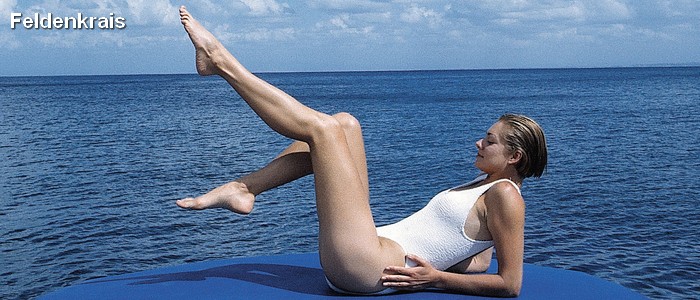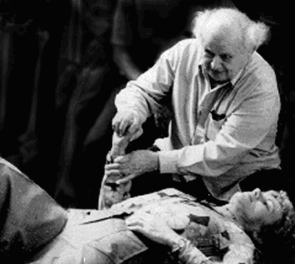By encouraging mindfulness of our body movements at a granular level, Feldenkrais claims we can weed out harmful physical patterns and replace them with healthful ones, like the way daily mindfulness meditation can enlarge those areas of the brain that produce healthier mental states.Falling For Feldenkrais: A Patient’s Progress
By Michael Sigman
What I'm after isn't flexible bodies, but flexible brains—Moshe Feldenkrais
For an obsessive swimmer who craves the endorphins, the past two years of failed therapies for a bum shoulder have been a bummer. I've been acupunctured, acupressured, cracked, Rolfed, electro-stimulated, nutritionized, lasered, therapized, osteopathed, hypnotized, rheumatologized, cortisoned, massaged, medicated, iced, heated, surgerized and more. Much more.
All these treatments have yielded benefits, except for the "much pain, no gain" neck-wrenchings of a certain Dr. Hertz. Our brief relationship ended when, after waiting an hour, I was asked to reschedule an appointment because Donald Sutherland had arrived. I love Donald—he was a super doctor in M*A*S*H!—but not that much. I would happily have stepped aside for his son Kiefer, a.k.a. 24's Jack Bauer, though, so he could save civilization as we know it before the next commercial break.
But it always seemed the healer was doing something to me or instructing me to adhere to a specific, do-or-die nutrition, exercise or stretching regimen. Some gave interesting advice that didn't quite address the problem at hand, like the enigmatic Zen acupuncturist who said little during our sessions except, "You must eat very slowly and chew each bite at least 40 times before swallowing."
Advice is frequently contradictory. Ice or heat? Breathe in or breathe out? Rest or test? Meditate or medicate? Physical therapy or surgery? Yoga or Pilates? And where, exactly, is my core?
So when a friend told me I ought to check out Stacy Barrows, a Century City, CA-based Feldenkrais practitioner, I figured I had nothing to lose.
At our first meeting, Stacy took my history and then directed me to a massage table, I assumed for a vigorous shoulder workout. When she began touching my big left toe so lightly I could barely feel it, my New Age alarm went off.
My concerns about Stacy were assuaged when I learned that she's a licensed physical therapist and an articulate student of neuroscience who achieved Feldenkrais certification only after undergoing a four-year intensive training program. That she's also a certified Pilates instructor and a former competitive swimmer who's giving a seminar next month about how to improve your stroke was chocolate icing on the cake.
As for the toe/shoulder perplex, Barrows explained, "The Feldenkrais Method often involves work in a remote area of the body by helping a person make internal connections to improve a far-away injured or underdeveloped area. An injury can trigger guarding patterns that make the sore spot resistant to direct treatment. By offering clarity to a more receptive part of the body, the injured area becomes more relaxed and amenable to healing."
The Feldenkrais Method was named after Dr. Moshe Feldenkrais (1904-84), whose accomplishments included a mastery of physics, world-class status in judo and teaching 75-year-old former Israeli Prime Minister David Ben Gurion to stand on his head—Ben Gurion's head, that is. Drawing from such thinkers/healers as Mabel Todd, Kano Jigoro and Gustav Flechner and such disciplines as dance, yoga, Rolfing, the Alexander Technique and hypnotherapy, Feldenkrais facilitates self-healing through a science-based approach to movement and posture.
Instead of telling you how to stand, sit or move, the practitioner suggests you experiment with various gentle maneuvers until you find your own comfort zone, always noticing even slight increments of discomfort and stopping before pain sets in. In other words: no pain, much gain.
An inspirational story about the body's ability to teach the brain. A baby born 20 years ago without a third of her cerebellum was given a grim prognosis by medical doctors: she could never walk or talk. Now the young woman enjoys a nearly normal life and is a college student.She and her family attribute her amazing recovery to Feldenkrais, a unique therapy developed in Israel and based in part on the belief that the body can actually teach the brain. The technique is now used by more than 4,000 practitioners around the world. Posted at YouTube by Lightbridge Media.
You don't need a degree from Singularity University to know that the mind can accomplish astonishing things. Last month, Google founder Sergey Brin, before a large audience, manipulated a robot limb thousands of miles away by sending brain signals through a computer program. So it's hardly a stretch, pardon the pun, to believe—as Sandra and Matthew Blakeslee reveal in their book The Body Has A Mind of its Own—that another feature of Feldenkrais called motor imagery—imagining and visualizing an activity like piano playing or swimming — can be nearly as successful as actual physical practice.
I'm not talking about the faux philosophy of The Secret or the idiocy of Dodgers owners Frank and Jamie McCourt hiring a "healer" and a "Phrenology Consultant" to, respectively, impart positive thoughts to the team and examine the skull shapes of employees to eliminate "negatively karmic" influences.
Rather, by encouraging mindfulness of our body movements at a granular level, Feldenkrais claims we can weed out harmful physical patterns and replace them with healthful ones, like the way daily mindfulness meditation can enlarge those areas of the brain that produce healthier mental states.
After a couple of weeks of visits to Stacy and following up on my own, my shoulder feels a bit better and I'm able to swim for 20 or 30 minutes without too much pain. But, like Nassim Nicholas Taleb, author of The Black Swan, I'm a skeptical empiricist and don't want to get caught up in a pleasant narrative without more evidence.
In addition to treating an injury not at its location but rather paying attention to remote parts of the body that may seem unconnected, consider these five other common misconceptions, as per the Gospel according to Feldenkrais:
1. Faster is better. We're brought up to think that faster is better than slower and the more reps the merrier. In fact, we need to slow down and slow down and slow down. According to Feldenkrais expert Fred Onufryk, "When moving or exercising quickly, you can only do things how you have always done them. It's a habit. Moving slowly allows you be aware of what you are doing, lets you make distinctions and lets you choose a new and different way of doing things."
2. "Stretching out" the injured area facilitates healing. Static stretching exercises for specific areas — hamstrings, calves, arms, neck — are frequently unhelpful and often counterproductive. Barrows: "Our modern lifestyle — the hours we spend driving, sitting at the computer, watching TV, etc. — saps the dexterity and mobility that we had as children. We've thought we could loosen up via static stretching regimens but research shows that what we really need is to reestablish the fine-tuned coordination necessary to access that childlike flexibility. Our nervous system has become accustomed to bodily tension and immobility, and sets 'trip wires' to protect and limit our movement."
3. Good posture means standing straight and throwing your shoulders back. Posture is intimately related to movement, and we need many subtly modulated postures to maximize effortless movement. Think Michael Phelps gliding through the water. "Posture is generally taught as static when it's really a dynamic alignment that relies on spontaneous calibration of movement," Barrows says. "When people stop to think about how to stand or sit they often freeze in a position which sets up rigidity, and does not allow for resilience, adaptability with loss of balance, or shock absorption. The idea of straight is not an appropriate cue nor is pulling your shoulders back."
4. Strength — as in six-pack abs and rippling glutes — keeps us in shape and prevents injuries. Obviously we need strength, but intense weight-lifting and heavy calisthenics to develop the kind of muscles touted in Men's Fitness can hamper graceful movement. Barrows says, "We tend to look at strength to solve our movement problems, but unwanted muscle tensions — what Moshe Feldenkrais called 'parasitic contractions' — are merely useless holding patterns that actually interfere with movement." According to Jeff Haller, PhD., "Dr. Feldenkrais would say, 'I'm teaching you to be strong.' I believe he meant for us to have the internal resources to meet the necessity of the changing moment." "This can only be accomplished with trained muscular sensitivity," Barrows adds.
5. No pain, no gain. Feldenkrias emphasizes only movements that are comfortable. When something starts hurting, the teaching is to stop doing it. As with other movement modalities like yoga, Alexander Technique and tai chi, body awareness, flexibility and resilience tie everything together.
After several weeks of Feldenkrais treatments and classes, my shoulder and hip are noticeably — though not dramatically — improved. I'm moving more freely and—dare this born-and-bred skeptical New Yorker say it?—enjoying a greater overall sense of well being and connectedness (http://www.youtube.com/watch?v=mVoPG9HtYF8). Placebo effect? Power of suggestion? Maybe, but I'm giving long odds that this is for real.
I asked a very skeptical New York friend whether all this sounded a bit woo woo. He told me his son—whose various physical, mental and emotional pains had grown so severe they nearly led to suicide—tried a plethora of treatments, to no avail. My friend didn't understand it and couldn't explain why the Feldenkrais Method turned things around and helped save his son's life. He just knew that it did.
If this is placebo, I'll take two.
For more info: http://feldenkraisguild.com;
http://www.feldenkraisinstitute.com/;
http://feldenkraisinstitute.com/about_feldenkrais/videos_articles_pressWriter/editor, media consultant, music publisher Michael Sigman is a regular Huffington Post blogger. Follow Michael Sigman on Twitter: www.twitter.com/majorsongs
THE BLUEGRASS SPECIAL
Founder/Publisher/Editor: David McGee
Contributing Editors: Billy Altman, Laura Fissinger, Christopher Hill, Derk Richardson
Logo Design: John Mendelsohn (www.johnmendelsohn.com)
Website Design: Kieran McGee (www.kieranmcgee.com)
Staff Photographers: Audrey Harrod (Louisville, KY; www.flickr.com/audreyharrod), Alicia Zappier (New York)
E-mail: thebluegrassspecial@gmail.com
Mailing Address: David McGee, 201 W. 85 St.—5B, New York, NY 10024
Founder/Publisher/Editor: David McGee
Contributing Editors: Billy Altman, Laura Fissinger, Christopher Hill, Derk Richardson
Logo Design: John Mendelsohn (www.johnmendelsohn.com)
Website Design: Kieran McGee (www.kieranmcgee.com)
Staff Photographers: Audrey Harrod (Louisville, KY; www.flickr.com/audreyharrod), Alicia Zappier (New York)
E-mail: thebluegrassspecial@gmail.com
Mailing Address: David McGee, 201 W. 85 St.—5B, New York, NY 10024



